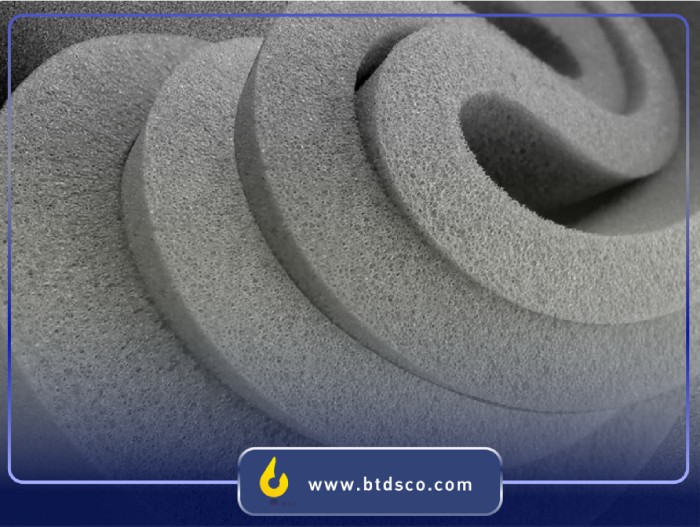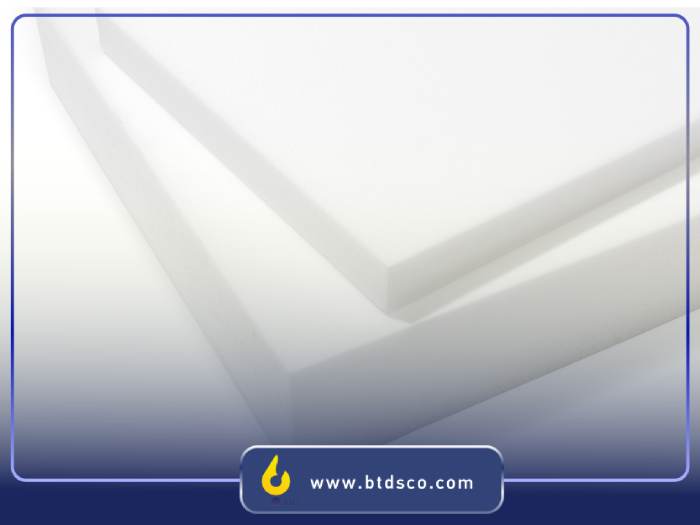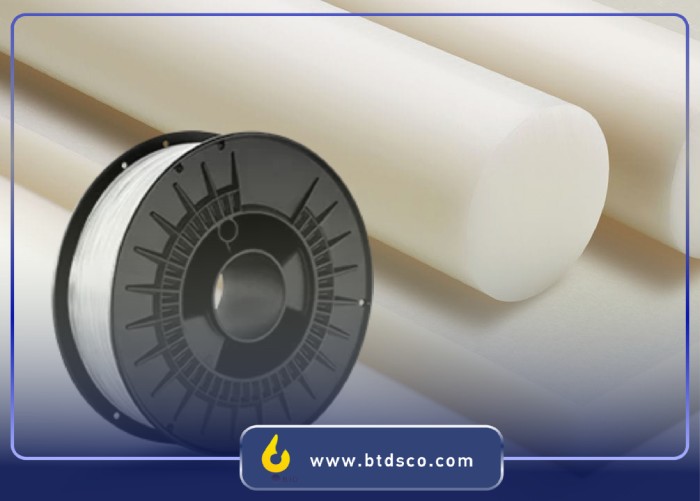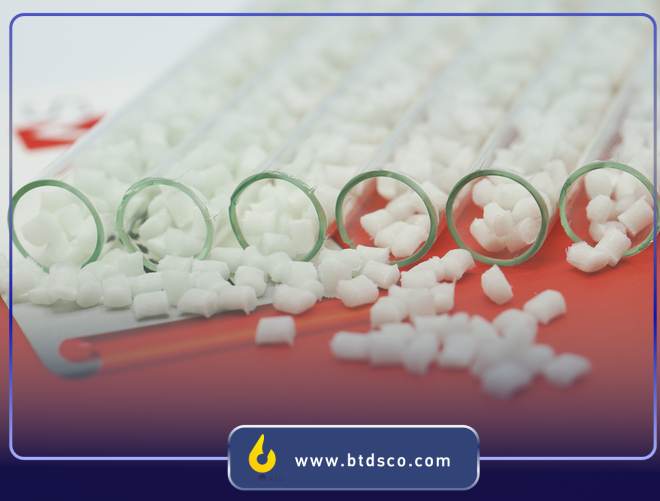Challenges and Opportunities of Using Polyamide in the Pipe and Fittings Industry

In the dynamic world of pipe and fittings manufacturing, choosing the right material can make the difference between an efficient, durable system and a costly, underperforming project. Polyamide compounds, one of the most advanced engineering polymers, offers unique properties such as high mechanical strength, flexibility, and chemical resistance, making it an attractive option for producing pipes and fittings in a wide range of applications, including industrial fluid transfer, electrical conduit systems, and hydraulic lines.
However, challenges such as moisture absorption and production costs add complexity to its use.
At Baspar Tose’e Dovam Shimi, we are committed to providing innovative solutions and high-quality raw materials that empower industry professionals to use polyamide with confidence.
Based on global research and industrial experience, this article explores the importance of material selection, key advantages and challenges, comparisons with competing polymers, emerging opportunities, and market outlook—positioning polyamide not merely as a material, but as a strategic solution.
The Importance of Choosing the Right Material in Pipe and Fittings Production
Selecting the right material is the foundation of success in industrial and construction piping projects. This choice impacts not only performance, durability, and safety but also overall costs, maintenance, and environmental compatibility.In industries facing challenges such as hydraulic pressure, temperature variations, corrosive chemicals, and mechanical stress, materials like polyamide can provide an ideal balance between performance and cost-efficiency.
Key Factors in Material Selection
- Mechanical Performance: Pipes must resist wear, impact, and creep (gradual deformation under constant load). Polyamide, with a tensile strength of 80–100 MPa, is ideal for high-pressure applications.
- Chemical and Thermal Resistance: In industrial environments, materials must withstand weak acids, bases, and temperatures from -40°C to +120°C. According to ISO 9080, polyamide pipes can handle pressures up to 25 bar.
- Economic and Environmental Considerations: Production and recycling costs, combined with significant weight reduction (up to 70% lighter than metals), affect ROI. In Iran, leveraging locally available materials like polyamide can reduce dependence on imports.
Safety Standards: Compliance with standards such as ASTM D2513 (gas pipes) and EN 1555 (polymer pipes) ensures safety. Incorrect material choice can lead to leaks, contamination, or structural failure.
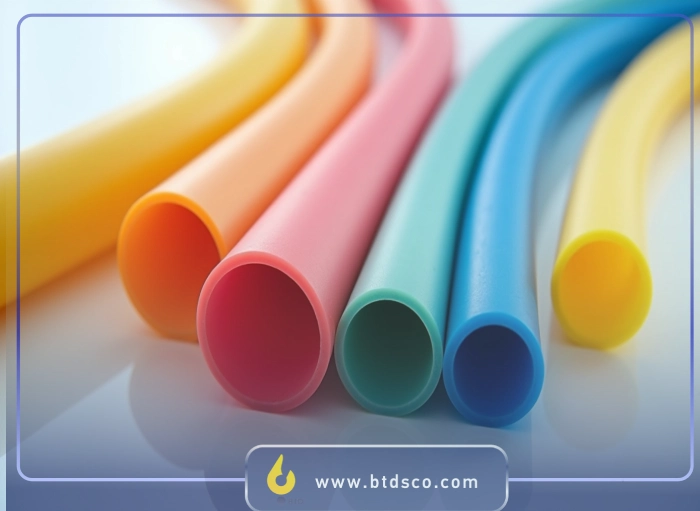
Impact on Different Industries
In oil and gas, using materials like polyamide can extend pipe lifespan from 20 to 50 years and reduce maintenance costs by up to 40%. In construction, polyamide electrical conduits enhance fire safety.According to McKinsey reports, poor material selection costs industries billions annually, while smart choices can improve productivity by 25%. Baspar Tose’e Dovam Shimi supports clients by offering technical consulting and high-quality raw materials tailored to specific project requirements.
Why Polyamide Is Used in Piping Applications
Polyamide, with the repeating chemical structure (-[NH-(CH2)n-CO]-), is a semi-crystalline thermoplastic derived from caprolactam (PA6) or from hexamethylenediamine and adipic acid (PA66).
It’s widely used in piping systems due to its excellent balance of mechanical strength and processability, serving as a reliable alternative to metals and traditional polymers like PVC.
According to the Iranian National Polymer Industries Association, over 50,000 tons of polyamide were produced in 2023, with around 20% used in pipe and fittings applications.
Main Applications
- Electrical Conduits: PA6 conduits protect cables from heat and impact, offering tight bend radii (down to 3× diameter) and self-extinguishing behavior.
- Fluid Transport: In oil and gas, PA12 pipes are used for fuel and hydraulic lines due to low permeability to gases and oils.
- Industrial Piping: PA11’s flexibility allows easy installation in pneumatic and vacuum systems.
- Global Standards: Compliance with DIN 8074 and ISO 1167 makes polyamide suitable for international projects.
In Iran’s humid southern climate, UV-stabilized grades of polyamide are ideal for underground installations.
Research from MIT shows polyamide pipes have 30% less leakage compared to PVC.
Advantages of Polyamide in Pipe Manufacturing
Polyamide enhances system performance with its superior mechanical properties.
Its high tensile strength (70–90 MPa) and exceptional abrasion resistance (up to 10× higher than PVC) make it ideal for demanding environments.
Strength and Durability
Chemical Resistance: Excellent resistance to oils, greases, hydrocarbons, and aliphatic solvents—ideal for fuel lines. According to ASTM D543, PA66 resists about 95% of common industrial chemicals.
- Thermal Stability: Operates reliably from -40°C to +150°C without deformation—suitable for steam and vacuum pipes.
- Mechanical Durability: High impact strength (IZOD up to 150 J/m) and low creep can extend service life up to 50 years.
Lightness and Flexibility
- Lightweight: Density of 1.14 g/cm³ (50% lighter than steel), reducing transport and installation costs by up to 30%.
- Flexible: Elastic modulus of 2–4 GPa allows bending without fracture; bend radius 3–5× pipe diameter.
- Easy Processing: Efficient in injection molding and extrusion, reducing production waste by up to 20%.
In electrical installations, PA6 conduits enable 40% faster installation, and in Iranian gas projects, PA12 pipes have reduced leakage by 25%.

Technical Challenges of Using Polyamide
Despite its strengths, polyamide presents some engineering challenges that require careful control.
Moisture Absorption
- Issue: PA6 absorbs up to 9% moisture, causing dimensional change (up to 0.5%) and a 20–30% drop in strength,critical in humid environments.
- Solution: Use PA12 (1.5% absorption) or apply hydrophobic coatings like polysiloxane.
Cost
- Production Cost: 2–3× higher than PVC (approx. 150,000–200,000 IRR/kg in Iran) due to expensive monomers like caprolactam.
- Impact: In large projects, total cost may rise by 15–20%, but the longer service life (up to 50 years) offsets this.
Processing
- Thermal Sensitivity: Shrinkage of 1–2% during cooling; requires precise temperature control (220–280°C).
- UV Stability: Susceptible to sunlight degradation; needs UV stabilizers (adds 5–10% to cost).
Flammability: UL94 V-2 without additives; in electrical pipes, flame retardants are essential.
These challenges are manageable with engineered grades like PA6 GF30 but require R&D investment.
| Property | Polyamide (PA) | Polypropylene (PP) | PVC |
|---|---|---|---|
| Tensile Strength (MPa) | 70–100 | 30–40 | 40–50 |
| Thermal Resistance (°C) | -40 to +150 | -20 to +100 | -10 to +60 |
| Flexibility | Excellent | Good | Moderate |
| Chemical Resistance | Excellent (oils, weak acids) | Good (acids, bases) | Moderate (solvent-sensitive) |
| Moisture Absorption (%) | 2–9 | <0.1 | <0.5 |
| Cost (IRR/kg) | 150–200k | 80–100k | 50–70k |
| Common Use | Hydraulic, Electrical | Sewage, Water | Water, Sewage |
- polyamide vs.Propelene compounds (PP): Polyamide offers higher flexibility and abrasion resistance, while PP is cheaper and more moisture-resistant—better for wastewater systems. PA excels in high-pressure applications.
- poplyamide vs. PVC: Polyamide is lighter and more heat-resistant, whereas PVC is cheaper and easier to install—preferred for domestic plumbing.
In Iran, PP holds about 60% of the piping market, while polyamide accounts for 15% in advanced sectors such as hydraulics.
Emerging Opportunities: High-Pressure and Specialized Polyamide Pipes
Polyamide opens new opportunities in high-performance and specialized applications.
High-Pressure Pipes
- Reinforced PA12: Handles pressures up to 100 bar—ideal for offshore oil and gas lines. Example: Gulf projects report 30% leak reduction using PA12.
- Nano-Polyamide: Adding nanoparticles (e.g., graphene) boosts strength by 50% and reduces weight.
Specialized Applications
- Smart Electrical Conduits: Polyamide integrated with sensors for temperature and pressure monitoring in power networks.
- Bio-Based PA11 Pipes: Derived from castor oil, offering sustainability and reduced carbon footprint for agricultural systems.
- Automotive Hydraulic Lines: 40% lighter than metal alternatives, improving fuel efficiency by up to 5% in heavy vehicles.
Market Outlook for Polyamide Pipes in Iran and Worldwide
The global polymer pipe market is expected to reach USD 100 billion by 2030, with a 5% CAGR. Polyamide, holding about 10% market share, is growing rapidly due to demand in renewable energy, automotive, and smart infrastructure.Despite sanctions, local PA6 production has become a strategic opportunity to reduce import dependency.Baspar Tose’e Dovam Shimi predicts 15% growth in demand for polyamide pipes by 2026, especially in industrial and energy sectors.
Conclusion and Recommendations
Polyamide offers an ideal combination of mechanical strength, light weight, and flexibility, making it a leading choice for modern pipe and fitting systems. However, issues such as moisture absorption and cost require careful management.
Baspar Tose’e Dovam Shimi recommends:
- Selecting suitable grades (e.g., PA12) for humid environments.
- Using UV stabilizers and flame retardants to enhance performance.
- Collaborating with experts for precise design and reduced manufacturing waste.
With professional guidance and quality materials, polyamide can become a strategic solution for your projects—unlocking opportunities such as high-pressure and smart pipe systems.
FAQs in using polyamide in pipe systems
What advantages does polyamide have over PVC in piping?
It offers higher heat resistance (-40°C to +150°C) and better flexibility, though costs 2–3× more
What is the main challenge of polyamide in humid environments?
Moisture absorption (up to 9% in PA6), causing dimensional changes and strength loss. PA12 (1.5%) is more suitable.
What is the market outlook for polyamide pipes in Iran?
Expected 15% growth by 2026, particularly in oil, gas, and water infrastructure
Is polyamide suitable for high-pressure pipes?
Yes. Reinforced PA12 can withstand up to 100 bar, ideal for oil and gas lines
How does the cost of polyamide compare with PP?
Recent Articles

